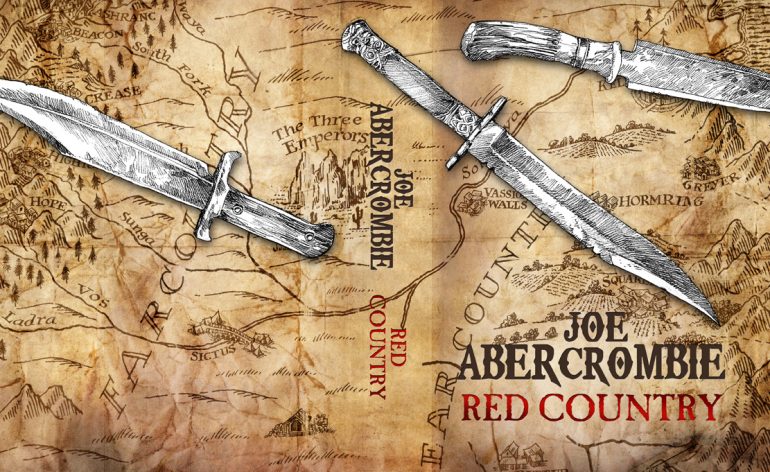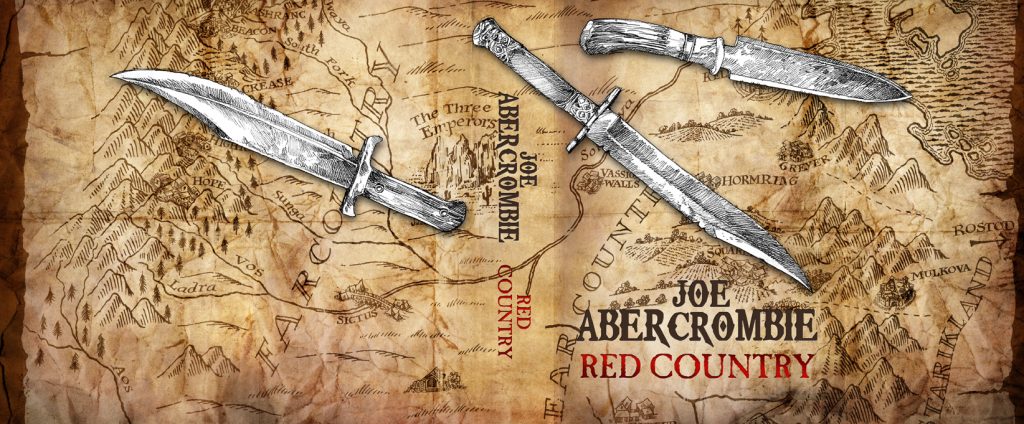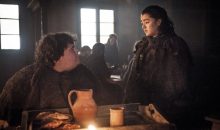Red Country
A few weeks ago, we discussed every book Joe Abercrombie has written. Every book, that is, but one. November 13th sees the US release of Red Country, our latest foray into Mr. Abercrombie’s bloody, grubby, hilarious-for-all-the-wrong-reasons world, and it’s a damned fun one. I’m not sure exactly where it ranks in the taxonomy of Joe-verse novels – The Heroes probably still gets my gold star – but it’s absolutely one of the best spec-fic books of the year.
Red Country contains a traditional Fantasy Book Map of the areas the story covers. Back in the First Law trilogy days, Mr. Abercrombie noted an opposition to maps, claiming that he didn’t want to marry himself to any details that he’d have to change later. Best Served Cold and Heroes both contained stylized, narrowly specific maps, but this is the first one that looks like one of those classic LOTR-style examples of imaginary cartography. This is kind of noteworthy because it shows Mr. Abercrombie’s growing comfort settling into this secondary world of his.
The area that map illustrates is largely referred to as the Far Country, a big untamed expanse of land bordering the ruined Old Empire. It’s an uncivilized place, and for every person there to civilize it, there’s three there to hurtle through and make whatever profit they can from the inhabitants; to say nothing of the people already there, the Ghosts (an interesting sort of European Dark Ages take on Native Americans). The spearhead of the settling effort is the Union of First Law, but there’s people from all over the world there, trying to get there before the government does.
In this lawless country lives farmer Shy South, a young woman with a bloody past and only as much of a future as she can coax out of the unforgiving dirt of her family’s farm. Shy isn’t quite one of Mr. Abercrombie’s best creations, for reasons that are hard to put my finger on; she’s a believably hard, washed-out woman with a tendency towards shitty decision-making under pressure (a trait shared by many of Abercrombie’s characters, and also a lot of real people), but lacks the narrative spark of previous protagonists – in other words, she’s no Monza Murcatto. Still, she makes a strong enough focal point for a story that starts when her two younger siblings are kidnapped from the farm, and it’s up to Shy and her aging, weak-willed stepfather Lamb to go and rescue them.
For safety, they join up with a caravan out for the lawless town of Crease; the wagon train is as classic a Western setup as ever there was, and I feel like I could spend an entire novel with this group and their toils and travails. Along the way, we meet the other main character, a jack-of-all-trades presently serving with a storied mercenary company as, of all things, their notary. This fellow, who goes by Temple (for his origins training as a priest in Gurkhul, the Ottoman Empire analogue of the books), is a man with good intentions but the moral fiber of uncooked pasta, and his story really begins with a decision to stand up for his one or two remaining principles. (Never a worthwhile decision when you’re working for Nicomo Cosca, who is back and more Cosca than ever.)
Temple is an interesting sort of hero, especially when compared to the men & women of action who’ve populated Mr. Abercrombie’s books and much of the sword-and-sorcery genre overall. He’s useless in a fight and hapless in the wilderness, and while clever, he only has a few narrow ways to apply that cleverness (though you’d be surprised how useful a lawyer can be.) Mostly he’s just…this guy, you know? And yet dragged along by outlaws, mercenaries, kidnappers, and the Most Frightening Man In the World (more on that later), he’s a great and convincing character without dipping too deeply into Audience Substitute.
Once the group reaches Crease, the book hits its second act, in which the various characters deal with a bad parody of civilization and get caught up in the struggle between the town’s two power players (one of whom is a returning character from First Law and Best Served Cold, delightfully schemey and morally unmoored.) It’s only at the denouement of this nasty little urban war that the trail of Shy’s missing siblings is picked up again, and that’s when things go nuts. The third act is a slice of Epic Fantasy tossed into the middle of this vicious medieval Western, with a tribe of dragon-worshipping Ghosts (that’s the Native American analogue) providing a final mad dungeon crawl for our heroes and their far less heroic mercenary support.
As I write this, I feel like I’m barely scraping the surface of the plot. There is a lot going on in Country, more than either of the last two stand-alones, but it manages to never feel unfocused; in part, it’s because Mr. Abercrombie just keeps the plot barrelling along, spending very little time meandering through the fascinating world he’s created. Every time we pause for breath, he has someone steal something or something get blown up or various other acts of malfeasance that keep Shy, Lamb & Temple moving along towards their goal. You can pack in an awful lot of plot that way. (Though, I should say, the slowest section – the travels of the caravan in the first act – is one of the strongest.)
The other key is that all of these happenings are filtered through the lens of a classic genre exercise; in this case, the American Western. It’s more overt than any of Mr. Abercrombie’s previous works; the caravan is an homage to Lonesome Dove, Crease is clearly the eponymous town of HBO’s Deadwood, and one of the main character plots of the book draws from Clint Eastwood’s great Unforgiven. Hitting those cultural cues makes for some great atmospheric shorthand, keeping a reader well-steeped in the Far Country’s lawless charm even when there’s five or six different things happening at once.
Oh, and while I’m mentioning Unforgiven, let’s talk about that a little. Shy’s stepfather, Lamb, is also a returning character, and a pretty significant one (whose identity is made obvious to readers of the previous books within a few pages of his introduction). Introduced as an affable, aging coward, Lamb (like Unforgiven‘s William Munny) very quickly descends back into old habits when his step-children are taken, and his continual backslide is the vein running through Country that provides the book its color. In an interesting device, his real name is never once spoken, even by characters who have every reason to; it provides him with a sort of mythic presence, improved by the fact that Mr. Abercrombie never really puts us inside his head. The climax of all this savage buildup is an absolutely terrific slice of suspense & violence, though the coda – the inevitable Western standoff, with another returning character who weaves in and out of the book with bad intentions to spare – is an interesting choice that I haven’t really made up my mind about yet.
Red Country isn’t without flaws. The third act, well-paced as it is, has a weird sort of out-of-nowhere quality that makes me wonder if Mr. Abercrombie just really needed to introduce the “Dragon people” to foreshadow something in his next book. And while the Western motif is great in and of itself, it’s a bit jarring to drop Dark Ages northern tribesmen and pre-Renaissance Union soldiers into the middle of a setting that owes a great deal to the cultural underpinnings of 19th-century America. It’s stitched together nicely, but sometimes you can see the seams.
But then, that’s part of what makes Joe-Verse (I really need a better name for that…) so interesting. The world is changing. Industrial technology is being introduced; The Heroes saw experimentation with cannons by the Union army, and now in the Far Country a new type of smithy that promises to make hammer-and-anvil fellows obsolete is introduced almost off-handedly. It’s not a static fantasy world; it’s a world in development, struggling to escape its blood-and-thunder past. Running through all of Mr. Abercrombie’s books, but especially this one, is the question as to whether this new world is going to have room for all the old people.
It’s no coincidence that some of the significant returning characters from previous books, such as Lamb, Nicomo Cosca, and the looming swordsman stalking Lamb through the Far Country, are all presented as rather out-of-place. Their actions, sensible or at least pragmatic from a certain point of view, shock and appall the people around them, and while solving the immediate problem often run the risk of creating a whole set of new ones. The world of Country might be trying to move on without them, but they’re doing their able best to either keep up or single-handedly arrest the world’s progress. Some of them might just be able to do that; the ones that don’t are going down kicking, screaming, and spilling gallons of blood.
As usual, Joe Abercrombie does a great job playing with the tropes that makes both speculative fiction and [insert other genre here] great, and telling a damned fun story along the way. Also, his endings seem to get a little happier with every book – though that’s not saying much, considering where he started. Red Country is a terrific read, one that benefits hugely from experience with his previous books but can stand alone pretty well. Read this, read them all; you’ll be glad you did.








Instead of calling it Joe-verse, there’s already a perfectly serviceable for this world. Most people call it Circle of the World.